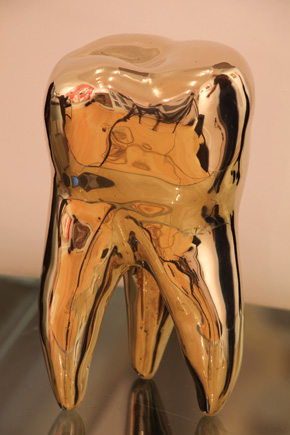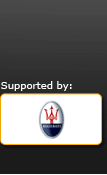|

David Shrigley’s artwork creates a world full of beast-like
people, hand-scrawled messages and indignant surrealism. The
British artist has always played around with different ways
of disseminating his work, so it’s no surprise to find
him at Frieze, doodling on visitors with temporary tattoo ink.
It’s a publicity stunt, he explains, for his new book,
but if he’d really thought about it he would never have
agreed to two, eight-hour shifts crouched over people with a
paintbrush.
Shrigley is an enthusiastic project-starter, game for anything.
He created a campaign for Pringle in early 2010, for instance,
and admitted that before he started he thought a twinset was
a kind of underwear.

He has also published more than 30 books, some with a print
run as small as 100. ‘My last book didn’t have my
name on the cover,’ Shrigley says. ‘It was commercial
suicide – and I knew that to start with. But that’s
the way it should have been.’ This one won’t be like
earlier works: art objects in their own right, too valuable
now for him to buy back.
By contrast, the new anthology has an initial print-run of
40,000, followed by a paperback, and will be his most widely-available
book to date.

It has taken a 19-year career, with exhibitions in London’s
Tate Modern and Saatchi Gallery, New York’s MoMA, Paris
and Berlin, to reach this kind of mainstream success. But when
he graduated from Glasgow School of Art in 1991, the mainstream
was just what Shrigley had in mind.
|
 |
He had fallen out of love with fine art during his degree and
made ‘a panic decision’ to be a cartoonist when he
left. Ironically, the only people who liked his work were his
fellow art-school graduates. It was artist and flatmate Jonathan
Monk who encouraged Shrigley to stick to the sketchbook-style
of illustration for which he is now celebrated.
Some accuse him of being little more than a cartoonist; for
Shrigley, the debate is long worn-out. ‘Anything can be
fine art, and the debate as to what is and isn’t becomes
tedious after a point. Any idiot can be taken seriously as a
fine artist. If my work functions as cartoons there’s no
artifice about what it is formally, whether you call it fine
art or not. There’s a precedent for everything.’
Shrigley published a handful of books and had barely finished
his first solo exhibition when he made the cover of Frieze magazine.
‘It was curious,’ he says, ‘as I hadn’t
really shown my work much at that point. I’d made a lot
of books – that’s how the article came about.’
The journalist was impressed by the way the young artist balanced
humour and despair in his work, a quality that is still present
today, if in more subtle ways.

International circuit
Frieze took Shrigley from Glasgow to the international exhibition
circuit and, in 1996, his work was exhibited in New York, Amsterdam,
Copenhagen and London. His second solo exhibition would not
take place until 2005; in the meantime, he produced a weekly
cartoon for The Guardian newspaper, published ten more books
and created two music videos.
| ‘ANY IDIOT CAN BE TAKEN SERIOUSLY
AS A FINE ARTIST. IF MY WORK FUNCTIONS AS CARTOONS THERE’S
NO ARTIFICE ABOUT IT.’ |
He has always kept the financial side of his career at arms’
length. ‘Either the work’s good or it’s not,’
he says. ‘Some of it’s good enough to be presented
in the gallery and if it’s not good enough, no-one sees
it. That’s how I measure my work.’

|
|
Shrigley says that an environment such as Frieze, packed with
thousands of artworks and collectors, seems alien to him.
‘I’m never exposed to the nature of how I make a
living,’ he says. ‘I like the fact that the work is
collected, and I’m well aware that some private collections
are very worthwhile to be in.

‘But I think it’s better for artists to separate
the way they make money from the way they work. I don’t
want to end up making decisions affected by how things sell
in case it adversely affects my work.’ When I ask him which
pieces he is proud to sell, he replies baldly that he likes
to sell the things that cost the most to make.
While his style has not changed dramatically over the years,
the tone seems to have evolved from the moral obsessions of
the 1995 work in Frieze magazine. The denial of meaning in artworks
such as the empty album sleeve for Worried Noodles (2006) and
the untitled prints from the same time, turned to morbidity
over the past few years.

His black comic sculptures, such as the taxidermied puppy,
I’m Dead, and the more sinister Dead and the Dying figurines,
both 2010, take the themes of religion and meaninglessness to
their ultimate standpoint. Shrigley has always had the power
to make his audiences laugh, but his work has become more uncomfortable
than ever recently.
Putting out an anthology after two decades of anticommercial
publishing might seem an unusual step. But given his track record,
it seems there’s no project too unusual for Shrigley, and
no signs that his distinctive style is losing steam.
What the Hell are You Doing? is out now, published by Canongate.
WORK FOR SALE
Brass Tooth, selling for £1,200 a piece at Cerealart Untitled
(A Pirate), sold for £3,600 in May 2006 at Phillips de
Pury, New York Nobody Likes You, limited edition print, is available
for £1,200 a print at Helium Foundation, London Several
drawings for sale at the Yvon Lambert Gallery, €2,000 a
piece Selected works from Stephen Friedman, prices available
on request
|














